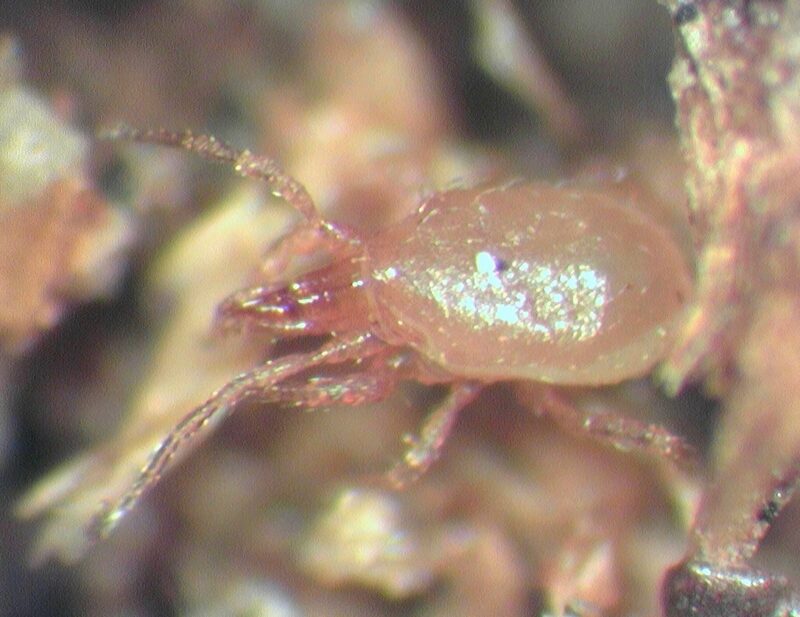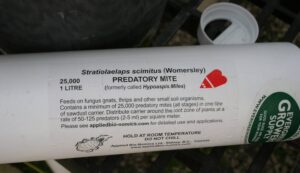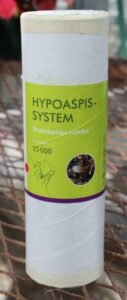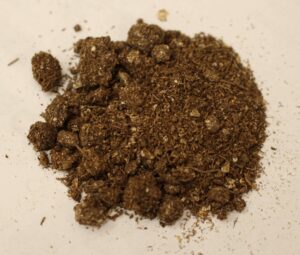
Dr. Bugs: Stratiolaelaps scimitus
The Dr. Bugs column helps GPN readers answer questions. In this column, Raymond Cloyd addresses biological control agents and information on fungus gnat larvae and predatory mites.
Question: I want to try using biological control agents against fungus gnat larvae. I have heard about a predatory mite. Can you provide information on the predatory mite?
Answer:

The predatory mite you are referring to is Stratiolaelaps scimitus (formerly Hypoaspis miles), which resides in the growing medium and feeds on the larval stages of fungus gnats. This article will discuss the biology, behavior, commercial availability and use of Stratiolaelaps scimitus in greenhouse production systems.
BIOLOGY AND BEHAVIOR
Stratiolaelaps scimitus females are approximately 0.4 millimeters long and light brown, with a pale-brown dorsal shield. Males are smaller than females. Females lay up to three oval-shaped eggs per day in the growing medium. The number of eggs laid by a female during her lifetime depends on the nutritional quality of the prey fed upon. Unfertilized females produce only males, whereas fertilized females produce males and females. A population can consist of 50% to 70% females.
Nonfeeding larvae emerge (eclose) from eggs in one to three days. The six-legged larvae become eight-legged nymphal stages (protonymph and deutonymph). Eggs and larvae are white. Nymphs are initially white, becoming light brown as they age. Nymphs are present for four to five days and become adults after six days.
The life cycle, from egg to adult, can be completed in 10 days at 82º F, 12 days at 75º F, 18 days at 68º F, and 34 days at 59º F. The optimum temperature for development and reproduction is between 59º F and 86º F.
Stratiolaelaps scimitus is shipped in 1-liter containers
with pasteurized peat (below) or sawdust.
Stratiolaelaps scimitus resides in the upper 1 inch of the growing medium. It is most active at temperatures up to 86º F with activity reduced when temperatures are lower than 57º F.
Stratiolaelaps scimitus nymphs and adults feed on fungus gnat, Bradysia spp., larvae. The nymphs and adults can consume up to 30 larvae per day. After capturing larvae, Stratiolaelaps scimitus insert their saw-like mouthparts into the body, cut apart the internal tissues and withdraw body fluids. In the absence of fungus gnat larvae, Stratiolaelaps scimitus will feed on algae and plant debris in the growing medium. Adults can survive three to four weeks without a food source.
COMMERCIAL AVAILABILITY AND USE IN GREENHOUSE PRODUCTION SYSTEMS
Stratiolaelaps scimitus is shipped in 1-liter containers with pasteurized peat or sawdust. Each 1-liter container has approximately 25,000 mites of all life stages (eggs, larvae, nymphs and adults).

Immediately release Stratiolaelaps scimitus upon arrival from the supplier. Distribute the predatory mites by shaking the contents of the container onto the growing medium surface. Stratiolaelaps scimitus then enters the growing medium. In addition, Stratiolaelaps scimitus can be applied to soil or gravel flooring underneath benches where fungus gnat larvae may be located.
Release Stratiolaelaps scimitus early in the crop production cycle when fungus gnat larval populations are low. One application of S. scimitus can establish a population for an entire growing season that will manage fungus gnat larval populations. Consult supplier information on release rates of Stratiolaelaps scimitus. The rove beetle, Dalotia coriaria, will feed on Stratiolaelaps scimitus, so do not use these two biological control agents simultaneously.

If Stratiolaelaps scimitus kills enough fungus gnat larvae, fewer adults will be present in subsequent generations; however, in most cases, using Stratiolaelaps scimitus alone will not be effective in managing fungus gnat larval populations. Therefore, releases of Stratiolaelaps scimitus should be used in combination with other plant protection strategies such as cultural controls (sanitation and proper watering) and applying insecticides.











 Video Library
Video Library 


















